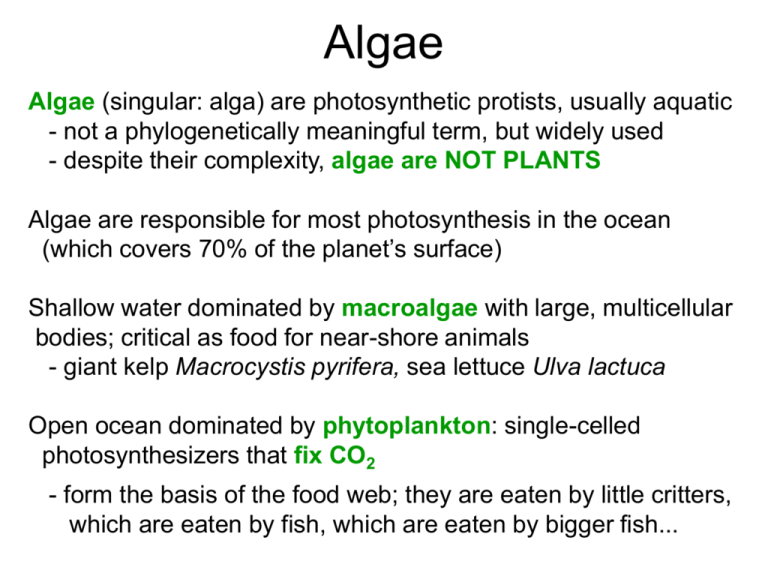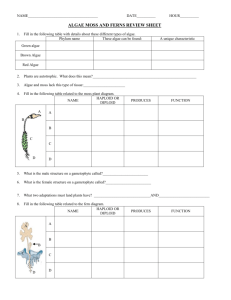Algae and Protozoa - Cal State LA
advertisement

Algae Algae (singular: alga) are photosynthetic protists, usually aquatic - not a phylogenetically meaningful term, but widely used - despite their complexity, algae are NOT PLANTS Algae are responsible for most photosynthesis in the ocean (which covers 70% of the planet’s surface) Shallow water dominated by macroalgae with large, multicellular bodies; critical as food for near-shore animals - giant kelp Macrocystis pyrifera, sea lettuce Ulva lactuca Open ocean dominated by phytoplankton: single-celled photosynthesizers that fix CO2 - form the basis of the food web; they are eaten by little critters, which are eaten by fish, which are eaten by bigger fish... Gametic life cycle No gametophyte (haploid body) -- Gametes are only haploid cells sperm + eggs Sporic life cycle common among multicellular protists like algae; one stage built out of haploid cells, another made of diploid cells Alternation of Generations: haploid & diploid stages may look different meiosis only occurs in the sporophyte stage Alternation of Generations Many protists exhibit alternation of generations, in which a multicellular haploid stage alternates w/ multicellular diploid stage 1) Meiosis produces spores (N, haploid), which grow into a whole haploid body called the gametophyte 2) The gametophyte produces gametes (sperm + eggs) by mitosis 3) Syngamy produces the zygote, “the baby” (2N, diploid) 4) The zygote grows into the sporophyte stage (2N, diploid), which undergoes meiosis... Macroalgae: 3 lineages Phylum Chlorophyta: Green Algae Chloroplasts very similar to those in true plants - chlorophyll a and b Green algae share a common ancestor with land plants, and are included in the “Kingdom Plantae” by some Some Chlorophytes live symbiotically with fungi as lichens, super-organisms that grow on rocks in moist terrestrial environments Phylum Rhodophyta: Red Algae Red from an accessory pigment, phycoerythrin - allows absorption of blue + green light, the wavelengths that penetrate the deepest in ocean water (red is reflected) Some have lost their plastids, become parasites on other algae - may explain why endosymbiosis occurred repeatedly in this group Nori, used in sushi rolls, is the red alga Porphyra Phylum Stramenopiles - Brown algae Largest, most complex multicellular colonies of any protist - convergent evolution has resulted in many plant-like features - blades look like leaves; stipes look like stems; holdfasts look like roots However, brown algae lack true tissues which exist in land plants Blade Stipe Holdfast Phylum Stramenopiles - Brown algae Giant kelp Macrocystis can grow 1 meter per day, 60 m in a year! - fastest growth rate of any organism on the planet Grows here in CA because coastal upwelling brings nutrientrich bottom water to the surface - supports a diverse community of fish + other animals that depend on the kelp to support the food web Phylum Stramenopiles - Brown algae Diploid (2N) sporophyte Haploid (1N) spores gametophytes (male + female) Microscopic photosynthesizers: 3 lineages Diatoms (Phylum Stramenopiles) Diatoms contribute half of the primary production in marine ecosystems - secrete 2-valve shell of silicate (glass) over plasma membrane Phylum Dinoflagellata Possess 2 flagella that twirl as they swim (Greek dinos, whirling) Can be autotrophic (photosynthetic), heterotrophic, or some can even switch back and forth (mixotrophic) Include the photosynthetic endosymbionts of hard corals Phylum Dinoflagellata Can cause red tides, up to 100 million cells per liter - use up all O2, leading to mass kills of sea life - locally, create intense bioluminescence in breaking waves at night Phylum Dinoflagellata Include photosynthetic endosymbionts of hard corals Can cause red tides, up to 100 million cells per liter - increasing in frequency, due to run-off from agriculture - produce potent toxins, which concentrate in filter feeders (clams, mussels) and are very dangerous to humans: - saxitoxins: Paralytic Shellfish Poisoning - other toxins: Diarrhetic or Amnesiac poisoning Economic development can occur at the expense of environmental quality Increasing incidence of red tides in Chinese seas … …coincident with increased economic Development (GDP) Liu & Diamond (2005) Nature 435:1179-1186 Animal-like protists Diverse heterotrophic lineages of eukaryotes Alveolates -- ciliates, Plasmodium (malaria parasite) Euglenids -- Euglena, Trypanosoma (sleeping sickness parasite) Amoebazoans -- Amoeba Diplomonads -- Giardia Alveolata: 3 related phyla Phylum Dinoflagellata – dinoflagellates Phylum Ciliophora– ciliates Phylum Apicomplexa– includes malaria parasite Note the diversity of metabolic processes and lifestyles found in this one group of protists – - parasites & endosymbionts - free-living heterotrophs - autotrophs & mixotrophs Phylum Ciliophora– Paramecium Bacteria are pushed along food groove into mouth by cilia Food is engulfed by phagocytosis, digested in food vacuoles Phylum Ciliophora Ciliated protozoans, eg. Paramecium - tiny hairs called cilia beat together, making water flow past the body propels cell forward Phylum Apicomplexa Plasmodium causes malaria, affects 500 million people and kills 2 million per year Spread by female Anopheles mosquito; can only complete its life cycle when syngamy happens inside a mosquito - stays inside our liver + blood cells; hard for our immune system to attack it - eats hemoglobin - contain a non-functioning plastid, formerly a green alga endosymbiont Phylum Kinetoplastida Trypanosomes – parasitic - have both an insect and a vertebrate host - Trypanosoma causes African Sleeping Sickness (tsetse fly) - other species cause leishmaniasis, Chagas’ disease (infect >20 million in Central and South America) Evade host immune response by constantly changing proteins that coat their cell surface, which would otherwise be recognized by antibodies produced by our immune system - rotate among 1,000 genes for surface proteins Single, elongated mitochondrion with entwined circles of DNA called the kinetoplast Phylum Euglenida Some are photosynthetic - like plants, plastid was formerly a cyanobacterium Move using a whiplike flagellum May only be asexual (very rare) Amoebae Named for pseudopods, temporary extensions of cytoplasm used in feeding and locomotion Look for action of water vacuoles -- organelles that collect water as it flows into the cell, then expel it so the cell doesn’t pop Phagocytosis: food particles are engulfed in vesicles, followed by intracellular digestion Foraminifera Related to amoebae, but with a shell of calcium carbonate covering plasma membrane Pseudopods extrude through holes in test, trap prey - empty shells contribute to carbonate depositions on sea floor (chalk layers, great pyramid building blocks) shell (calcium carbonate) Foraminifera Isotope composition of calcium carbonate shells = a record of past temperatures, critical for studies of past climate change Diplomonads Includes Giardia, the worst most awful parasite in the world (because it came after me) Weird cells: 2 nuclei, 8 flagella - lack mitochondria, Golgi, smooth Endoplasmic Reticulum once thought to be a transitional stage between prokaryotes and eukaryotes actually just very simplified cells that lost most features, which they no longer need because of their parasitic lifestyle





